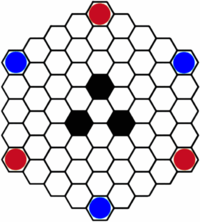58 (number)
| ||||
|---|---|---|---|---|
| Cardinal | fifty-eight | |||
| Ordinal | 58th (fifty-eighth) | |||
| Factorization | 2 × 29 | |||
| Divisors | 1, 2, 29, 58 | |||
| Greek numeral | ΝΗ´ | |||
| Roman numeral | LVIII | |||
| Binary | 1110102 | |||
| Ternary | 20113 | |||
| Senary | 1346 | |||
| Octal | 728 | |||
| Duodecimal | 4A12 | |||
| Hexadecimal | 3A16 | |||
58 (fifty-eight) is the natural number following 57 and preceding 59.
In mathematics
[edit]58 is a composite number, meaning its factor is 1, 2, 29, and 58.[1] Other than 1 and the number itself, 58 can be formed by multiplying two primes 2 and 29, making it a semiprime.[2] 58 is not divisible by any square number other than 1, making it a square-free integer[3] A semiprime that is not square numbers is called a squarefree semiprime, and 58 is among them.[4]
58 is equal to the sum of the first seven consecutive prime numbers:[5]
This is a difference of 1 from the seventeenth prime number and seventh super-prime, 59.[6][7] 58 has an aliquot sum of 32[8] within an aliquot sequence of two composite numbers (58, 32, 13, 1, 0) in the 13-aliquot tree.[9] There is no solution to the equation , making fifty-eight the sixth noncototient;[10] however, the totient summatory function over the first thirteen integers is 58.[11][a]
On the other hand, the Euler totient of 58 is the second perfect number (28),[13] where the sum-of-divisors of 58 is the third unitary perfect number (90).
58 is also the second non-trivial 11-gonal number, after 30.[14]
58 represents twice the sum between the first two discrete biprimes 14 + 15 = 29, with the first two members of the first such triplet 33 and 34 (or twice 17, the fourth super-prime) respectively the twenty-first and twenty-second composite numbers,[15] and 22 itself the thirteenth composite.[15] (Where also, 58 is the sum of all primes between 2 and 17.) The first triplet is the only triplet in the sequence of consecutive discrete biprimes whose members collectively have prime factorizations that nearly span a set of consecutive prime numbers.
is also semiprime (the second such number for after 2).[16]
The fifth repdigit is the product between the thirteenth and fifty-eighth primes,
58 is also the smallest integer in decimal whose square root has a simple continued fraction with period 7.[17] It is the fourth Smith number whose sum of its digits is equal to the sum of the digits in its prime factorization (13).[18]
Given 58, the Mertens function returns , the fourth such number to do so.[19] The sum of the first three numbers to return zero (2, 39, 40) sum to 81 = 92, which is the fifty-eighth composite number.[15]
In science
[edit]- The atomic number of cerium (Ce).
Other fields
[edit]
58 is the number of usable cells on a Hexxagon game board.
Notes
[edit]- ^ 58 is also the partial sum of the first eight records set by highly totient numbers m with values φ(m) = n: {2, 3, 4, 5, 6, 10, 11, 17}.[12]
References
[edit]- ^ Anjema, Henry (1767). Table of divisors of all the natural numbers from 1. to 10000. p. 3. ISBN 9781140919421 – via the Internet Archive.
- ^ Neil, Sloane; Guy, R. K. (22 August 2010). "A001358: Semiprimes (or biprimes): products of two primes". On-Line Encyclopedia of Integer Sequences. OEIS Foundation. Retrieved 22 April 2024.
- ^ Sloane, Neil (n.d.). "A005117: Squarefree numbers: numbers that are not divisible by a square greater than 1". The On-Line Encyclopedia of Integer Sequences. OEIS Foundation. Retrieved 22 April 2024.
- ^ Sloane, N. J. A. (ed.). "Sequence A006881 (Semiprimes (or biprimes): products of two primes.)". The On-Line Encyclopedia of Integer Sequences. OEIS Foundation. Retrieved 2024-05-07.
- ^ Sloane, N. J. A. (ed.). "Sequence A007504 (Sum of the first n primes.)". The On-Line Encyclopedia of Integer Sequences. OEIS Foundation. Retrieved 2022-12-20.
- ^ Sloane, N. J. A. (ed.). "Sequence A000040 (The prime numbers.)". The On-Line Encyclopedia of Integer Sequences. OEIS Foundation. Retrieved 2022-12-20.
- ^ Sloane, N. J. A. (ed.). "Sequence A006450 (Prime-indexed primes: primes with prime subscripts.)". The On-Line Encyclopedia of Integer Sequences. OEIS Foundation. Retrieved 2022-12-20.
- ^ Sloane, N. J. A. (ed.). "Sequence A001065 (Sum of proper divisors (or aliquot parts) of n: sum of divisors of n that are less than n.)". The On-Line Encyclopedia of Integer Sequences. OEIS Foundation. Retrieved 2024-02-27.
- ^ Sloane, N. J. A., ed. (1975). "Aliquot sequences". Mathematics of Computation. 29 (129). OEIS Foundation: 101–107. Retrieved 2024-02-27.
- ^ "Sloane's A005278 : Noncototients". The On-Line Encyclopedia of Integer Sequences. OEIS Foundation. Retrieved 2016-05-30.
- ^ Sloane, N. J. A. (ed.). "Sequence A002088 (Sum of totient function.)". The On-Line Encyclopedia of Integer Sequences. OEIS Foundation. Retrieved 2024-02-27.
- ^ Sloane, N. J. A. (ed.). "Sequence A131934 (Records in A014197.)". The On-Line Encyclopedia of Integer Sequences. OEIS Foundation. Retrieved 2024-07-02.
- ^ Sloane, N. J. A. (ed.). "Sequence A000010 (Euler totient function.)". The On-Line Encyclopedia of Integer Sequences. OEIS Foundation. Retrieved 2024-07-02.
- ^ "Sloane's A051682 : 11-gonal numbers". The On-Line Encyclopedia of Integer Sequences. OEIS Foundation. Retrieved 2016-05-30.
- ^ a b c Sloane, N. J. A. (ed.). "Sequence A002808 (The composite numbers.)". The On-Line Encyclopedia of Integer Sequences. OEIS Foundation. Retrieved 2024-05-07.
- ^ Sloane, N. J. A. (ed.). "Sequence A104494 (Positive integers n such that n^17 + 1 is semiprime.)". The On-Line Encyclopedia of Integer Sequences. OEIS Foundation. Retrieved 2024-02-27.
- ^ "Sloane's A013646: Least m such that continued fraction for sqrt(m) has period n". The On-Line Encyclopedia of Integer Sequences. OEIS Foundation. Retrieved 2021-03-18.
- ^ "Sloane's A006753 : Smith numbers". The On-Line Encyclopedia of Integer Sequences. OEIS Foundation. Retrieved 2016-05-30.
- ^ "Sloane's A028442 : Numbers n such that Mertens' function is zero". The On-Line Encyclopedia of Integer Sequences. OEIS Foundation. Retrieved 2016-05-30.







